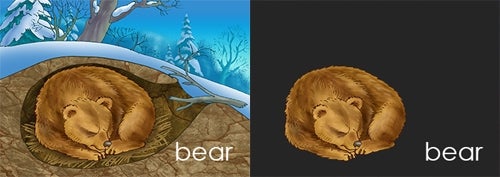Children hear as much sophisticated information about animals when parents read picture book stories about animals as when they read flashcard-type animal vocabulary books, according to a new study from the University of Waterloo.
“Marketers tell parents and educators that vocabulary books are more educational, so picture books are often dismissed as being just for fun,” said the study’s author, Professor Daniela O’Neill. “But our findings show that reading picture books with kids exposes them to information about animals in a way that allows children to readily apply this knowledge more broadly. This is key to learning.”
The study, by Professor O’Neill of the Department of Psychology at Waterloo, and Angela Nyhout, a graduate student, recorded 25 mothers while they read two books to their toddlers, each featuring six animals.
In one book, the animals were part of a story told in pictures. But in the other book, a picture of each animal was presented against a blank background, in the usual style of “vocabulary learning” books.

Example illustrations of the style that researchers used in books to study the language that parents use when reading with children. Researchers recorded 25 mothers while they read two books to their toddlers. In one book, the animals were part of a story told in pictures, but in the other book, a picture of each animal was presented against a blank background, in the usual style of “vocabulary learning” books. Download a high resolution version.
“What we found was that moms in our study used a special form of language – something called generics - as frequently when reading the picture storybook to their child as the picture vocabulary book,” said Professor O’Neill. “Generic language tells children about animals in general, not just about one animal. It’s the difference between saying ‘This giraffe has a long neck’ and ‘Giraffes have long necks.’ In the second case, we are more likely to learn something about all giraffes in general – that they all have long necks.”
When reading the picture book story, moms were also just as likely to provide facts about animals, such as “the squirrel likes to bury nuts” as when they read the vocabulary-style book.
“Our results are significant because they clearly show that books of all kinds can build children’s knowledge about the world, including picture book stories,” said Professor O’Neill.
The study appeared this week in the open access journal Frontiers in Psychology. It is published as part of a special Research Topic entitled An Open Book: What and How Young Children Learn From Picture and Story Books.
The Research Topic brings together researchers from disciplines including Psychology, Education and Communication Science for the first time to show the variety of different ways in which young children learn from sharing books with their parents.
“Children do learn a lot when parents read books with them and many parents read to their children several times each week,” said co-editor Professor Jessica Horst of the University of Sussex. “So, conducting studies using picture books and storybooks has important implications for understanding how children really learn in their daily lives.”
A Research Development Initiative grant, which the Social Sciences and Humanities Research Council of Canada awarded to Professor O'Neill, supported this research.